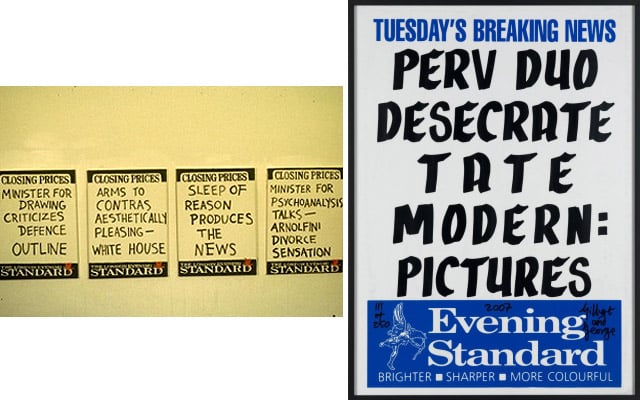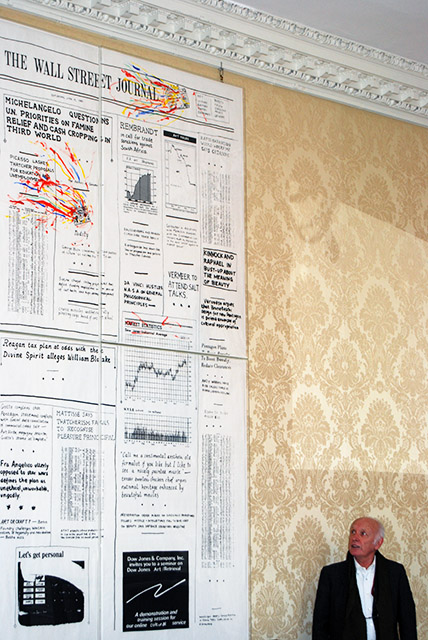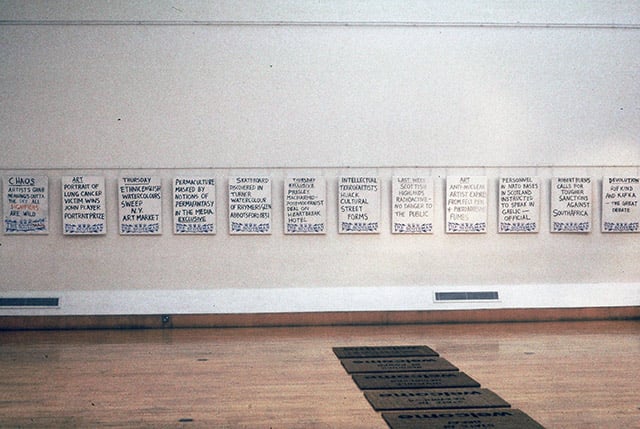

Artist and UC Davis professor Conrad Atkinson claims that art world darlings Gilbert and George ripped off a series of works of his from the late 1980s and early 1990s. He claims they did so in order to create a 2007 work shown that year at their Tate Modern survey Gilbert & George: Major Exhibition. Atkinson told artnet News that the Gilbert and George piece appropriates “both the form and the concept” of works from his Billboard series. Atkinson’s lawyer was less diplomatic in his views about the Gilbert and George work, calling it, “a complete rip-off … It is a work that primarily utilizes/usurps Conrad’s idea.”
Atkinson says that an individual brought his attention to the situation last month and that he has subsequently sought legal advice from his gallery. He claims that he contacted Gilbert and George’s London gallery, White Cube (which sells Perv Duo Desecrate Tate Modern: Pictures (2007), an edition of 250, for £612) via post and email to express his concerns. Thus far, he says, he has not received a response.
When contacted by artnet News, White Cube’s press representative declined to comment on the matter.
The artist has yet to decide whether to pursue formal legal action.
Speaking to artnet News, Atkinson said that the Billboard series originated from a commission by fine art print publisher Sean Elwood in 1985. Atkinson, Joseph Beuys, Ida Applebroog, and artist duo Komar and Melamid each contributed a piece to a portfolio. For his contribution, Atkinson created a fictional Wall Street Journal cover in which artists replace the front page’s typical cast of politicians and masters of industry.

Conrad Atkinson with his piece Wall Street Journal (1988) at 11 Downing Street.
Photo: Courtesy of Conrad Atkinson.
A later, large-scale work, Wall Street Journal (1988), currently hangs in 11 Downing Street, the official residence of Britain’s chancellor of the exchequer. It is displayed opposite a similar Financial Times work and sports fictional article titles like “Michaelangelo Questions UN Priorities on Famine Relief and Cash Cropping in Third World” and “Reagan Tax Plan at Odds with the Divine Spirit, Alleges William Blake.”
Witty art puns aside, the placement attests that Atkinson’s work was by no means sidelined in reception. According to the artist, Art in America‘s longtime editor-in-chief, Betsy Baker, commissioned Atkinson to create a set of newspaper pages for the magazine. “Then the Guardian commissioned me to do an actual [newspaper] page in 1989,” Atkinson says. Others, including the San Diego Tribune, followed suit.
Later in 1989, Atkinson made the first of an ongoing series of works based on Evening Standard sandwich boards, which are most readily mirrored in Gilbert and George’s 2007 series, according to the artist. Atkinson’s works were shown at the Talbot Rice Gallery, a museum affiliated with the University of Edinburgh, where he was then an artist in residence. Ten works similar to those shown in Edinburgh were purchased by the Glasgow Museum of Modern Art in 2013. He believes that they have been on view at the museum since January 2014.

Works from Conrad Atkinson’s Billboard series installed at Talbot Rice Gallery in 1989.
Photo: Courtesy of Conrad Atkinson.
It is unclear if Gilbert and George had any foreknowledge of Atkinson’s work when making Perv Duo Desecrate Tate Modern: Pictures (2007). (Whether an artist can claim to own the idea of using newspaper advertising boards for witty conceptual messages is an altogether thornier question.)
“The particular text they’ve used and much of their work seems to me self-loathing,” Atkinson says. “It is also a fairly major departure from their usual work,” he adds, about the 2007 work itself. “The text is also differing from many of my texts, which are about art politics and issues in a fairly lighthearted and ironic way.”
Atkinson says he only recalls meeting but not speaking to the duo once in the 1970s at a short-lived artist bar in Whitehall. Needless to say, they didn’t make a particularly positive impression then, either: “To be honest, I’ve always found them an unpleasant couple, artistically and as personalities,” he told artnet News.






